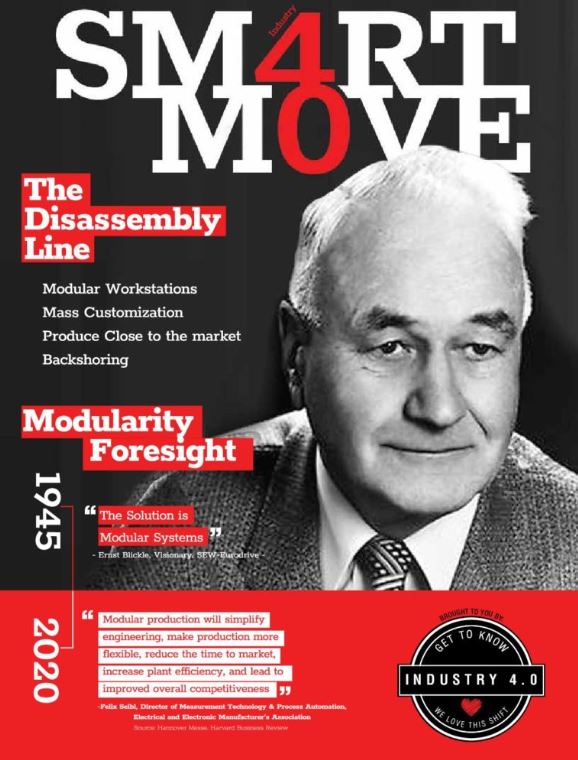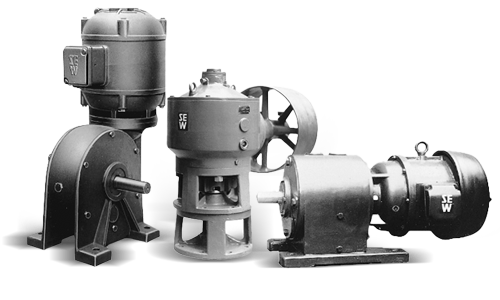
The Problem
It’s funny how history repeats itself—always reemerging with the same premise, but adapting to what is relevant at the time. In the 1960s and 70s, milk and other perishables were delivered straight to our doors, and then one day, the service just vanished. Today, delivery of groceries (or anything, for that matter) transcends in-store sales. Predicting how the market is going to react to new ideas certainly isn’t easy; even with sophisticated forecasts, AI analytics, and algorithms, as we all have learned, there’s never a 100% guarantee. But what about the people who created the products we didn’t even know we wanted, all based on a hunch? That is pure brilliance!
One understated example of foresight into the idea of Made-to-Order and modularity is that of Ernst Blickle (Visionary, SEW-Eurodrive). In 1945, Blickle took over management at SEW-Eurodrive. He was a forward-thinking entrepreneur, and was able to identify that the market needed drive solutions which were industry specific—before even the market had realized it. At the time, the status quo was building customer-specific gear unit-motor combinations that delayed delivery times, required custom tooling, and also came along with enormous price tags—all major pain points for any growing industry.
His solution was modularity. Blickle developed a flexible and affordable modular system of gear units and motors which could be implemented in industrial series productions with low unit costs, allowing his products to be fitted and configured to the exact specifications the customer requested—without any major disruption in the assembly process.
What Blickle did for SEW-Eurodrive back in the ’60s was essentially lay the groundwork for product customization on a grand scale. Infusing modularity into a high volume production process gave the once thought of linear assembly line, the flexibility to deviate from its path without losing productivity.
Today, modularity and flexible design are being paired with advanced manufacturing technologies. And once again we see history come back, but this time, it’s driving an autonomous-electric car.
Read how SEW-Eurodrive has progressed over 60 years, and how its knowledge can help guide you into the next industrial revolution.
Does modularity
mean the Extinction
of the assembly line?
Shifting to mass customization
The traditional assembly line is quickly becoming smarter, manufacturing had primarily been characterized by craftsmanship and uniqueness, when consumers used to buy customized items that had been created just for them, and which often became points of pride for the makers.
However, Henry Ford would soon come along and change all of that, and manufacturing would instead become defined by economies of scale, repeatability and affordability.
Now almost 100 years later, Industry 4.0 has begun ushering in an era of customization-with the key difference being that, this time, it is happening on an unprecedented scale. Technologies like IIoT, big data, 3D printing, and robotics are all at the core of this new revolution. Traditionally, personalization meant losing some volume, and was only available only at a premium. However, consumers can now place orders for customized cars, mobile phones, and even machines, which will be all manufactured at scale and then delivered to each consumer on-time. This is made possible due to the ability of robots and other machines to be rapidly configured and then reconfigured to adapt to all the different specifications that the customer provides.
Source: Research Gate
Digitalization enables mass customization.

1: Cyber Physical Systems Source: Research Gate
1: Cyber Physical Systems Source: Research Gate
Interestingly, these trends are not only evident within the B2C segment, but also in B2B. For example, Hoffman, a subsidiary of Pentair, provides custom electrical closets and website Flying-parts.com, which manufactures co-designed parts at a fraction of the cost of those being offered by traditional aviation parts manufacturers. Some other, more conventional B2B sectors (such as construction and glass manufacturing) are also beginning to adopt mass customization models, with a keen focus on 3D printing technologies.
Lean customization, is another interesting trend arising from mass customization in which manufacturers make use of just-in-time inventory and digital technologies to produce items at scale, and at low prices.
A good example of this is Liberty Bottleworks, whose plant in Portland, Oregon manufactures about 70,000 aluminum drinking bottles every month. Even though the company’s size and scale doesn’t come close to that of Chinese manufacturers, its bottles are still effectively competing with them in retail stores all throughout the US. According to the company’s COO, Ryan Clark, the main reason for this is lean customization, which allows for consumers to choose the exact shape, size, color and graphic that they want on their bottle, at no extra cost to the company.
SO What can this mean
For you?
For you?
Production is moving closer to centres of demand.
Over the last two decades, major corporations have been outsourcing their manufacturing to low cost regions such as Greater China (electronics), Mexico (clothing), Vietnam (shoes), and so on. And although these global supply chains come with the attractive benefit of cheap labour (resulting in low product costs), disadvantages such as long lead-times, low flexibility, instability in supply chains, poor quality standards and rising labour costs have all begun to drive manufacturing to be geographically closer to the consumer.
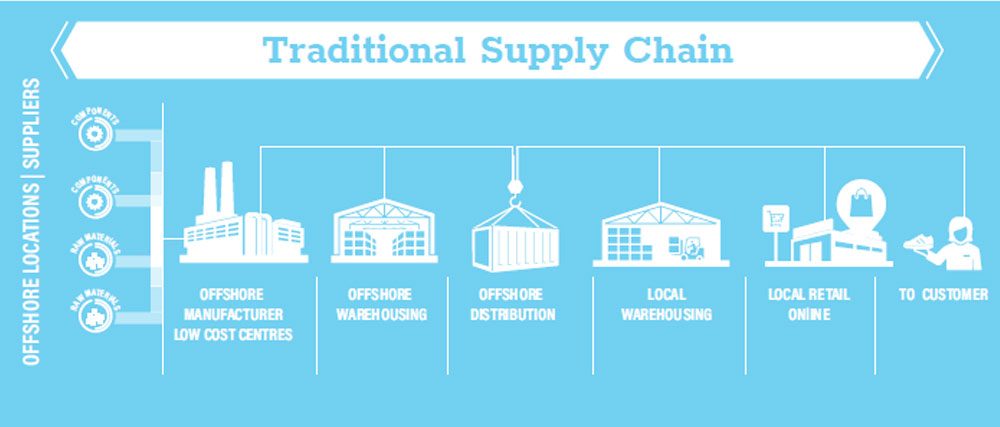
Source: spare-parts-3d.com
The largest catalyst of this change, however, is the advent of the smart factory-which, when coupled with the increasing consumer appetite to have customized products delivered to them quickly, is starting to push production back closer to the markets from which the demand originates. One of the major benefits to this approach is the shortening of the supply chain; distant mass production centers simply have too many stages in the value chain, including transportation, warehousing, insurance, manpower, etc., which not only serves to increase costs manifold, but also extends the time it takes to get a new product to market. For example, it took Adidas 18 months to get a new shoe to market from the design phase from its factory in Vietnam. This is a very long time, especially in a market like trainers, which is particularly sensitive to shifting trends. Realizing this, the company opened its first automated Speedfactory in Germany in 2015, soon followed by another one in Atlanta, Georgia in April 2018, with Adidas estimating for the two factories to have produced one million pairs of shoes by 2020.
Smart Manufacturing reduces supply chain complexity.
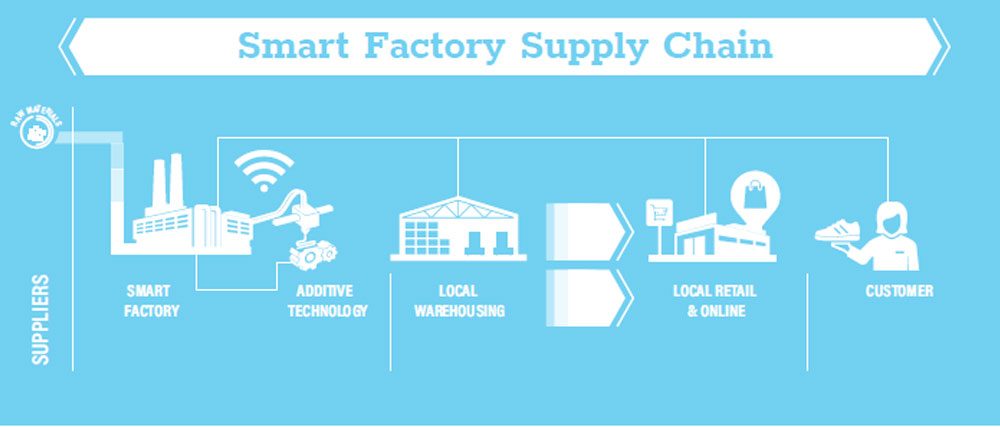
Source: spare-parts-3d.com
According to Herbert Hainer, former CEO of Adidas, smart manufacturing is taking the industry towards an on-demand manufacturing model which will see customized shoes being delivered within as quickly as a day of their creation. Apart from a drastic reduction in time, this trend will also be crucial in keeping up with the growing demand for customization.
“In a sense, we will re-shore production more and more. The future is in more
mass customization and this means more local production – because we have to shorten
the logistics chain from the production side to the side of the user.”
-Dr Detlef Zühlke. Chairman at the SmartFactoryKL Technology- Initiative
Source: Source: Hannover Messe, Harvard Business Review
High Labour costs less important for setting up manufacturing activities.
1: Backshoring (also known as onshoring or inshoring) is the process
of moving the production from low cost countries back to the
home countries, despite higher labour costs.
Source: German Manufacturing Survey 2015, Fraunhofer ISI

Fast Forward to 2020.
And the founding principles are once again at the forefront of today’s industrial demands. SEW-Eurodrive’s new systems solution branch (MAXOLUTION®) inherits the same guiding values discovered by Blickle—adapted for today’s smart factory. MAXOLUTION® is an Industry 4.0 system solutions provider that designs, manufactures, and services flexible and modular advanced manufacturing processes for a vast array of industries. The Innovation Lab ( Lab ONE), allows Canadian Industries to see, first-hand real-life working examples of modular, advanced manufacturing processes.
Source:SEW-EURODRIVE, LIVE LAB- Humber College, Barrett Centre for Technology Innovation (CTI).
Fast Forward to 2020.
" Modular Production will Simplify Engineering,
make production more flexible, reduce the time to market, increase plant efficiency, and lead to improved overall competitiveness".
-Felix Seibl, Director of Measurement Technology & Process Automation, Electrical and Electronic Manufacturer’s Association.
LAB ONE OPENS OCTOBER 2019
SEW-EURODRIVE opens its MODULAR Industry 4.0 Live Lab at Humber College, Etobicoke ON.
LEARN MOREAGVs
Autonomous guided Vehicles are guided and powered by an invisible inductive charging line concealed beneath the floor. The power supply is continuous and does not require ongoing maintenance.
Pick By Light
Pick by light, paired with AR, streams real-time, step-by-step Instructions to the worker. Each parts bin has its own indicator light, showing the worker which part is required in the assembly process and dramatically reducing assembly errors.
AR
Augmented Reality allows the worker to interact with software while performing physical tasks simultaneously. It’s like having a digital work coach helping guide the worker.
Modularization paves the way for efficient mass customization.
It’s been about 100 years since Henry Ford gave the automotive industry its first assembly line. Since then, cars have been manufactured in a fixed, sequenced line consisting of pre-defined, rigid processes. In other words, once an assembly line is designed for a particular model, it cannot be changed throughout the lifecycle of a car, and dictates the intra-logistical processes of the production and supply chain.Because of these restrictions, if an auto manufacturer wants to release a modified version of a particular model, it cannot do so without first creating a different assembly line and thereby incurring huge costs. Other industries (such as apparel, pharmaceutical and chemical) are also facing a similar problem in the face of the increasing demand for customization. To create an agile and flexible production process, companies are now making use of the concept of modularization.
Source: Hannover Messe, Harvard Business Review.
Feel Free to download a PDF version of this Article.
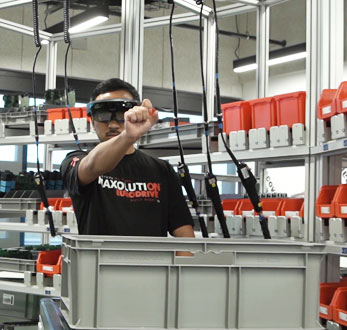

AUGMENTED REALITY
Augmented Reality (AR) is an interactive computer interface that overlays real life.
AR provides the worker with detailed assembly instructions, diagrams and relavant information in realtime.
VISIT LAB ONE
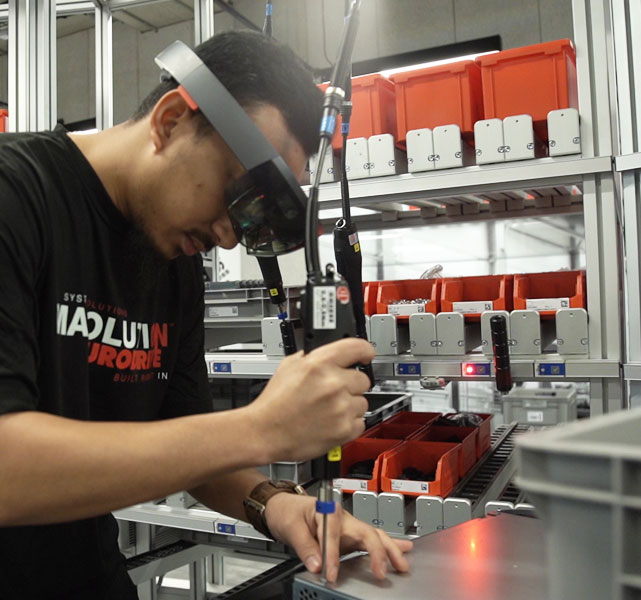

PICK BY LIGHT
Pick by light, paired with AR, streams real-time, step-by-step Instructions to the worker.
Each parts bin has its own indicator light, showing the worker which part is required in the assembly process and dramatically reducing assembly errors.
VISIT LAB ONE
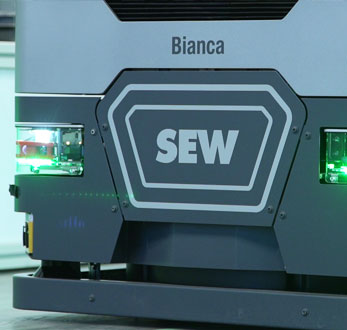

MOVITRANS®
MOVITRANS® is a sophisticated, no-contact inductive charging system
that provides constant power to your AGVs.
Due to it’s contactless, friction-free nature, MOVITRANS® requires very little maintenance and will accommodate a wide array of complex motion plans.
MORE MOVITRANS®


INTELLIGENT QC
The worker completes the product's as sembly and places it on an automated Guided Vehicle (AGV), then the AGV shuttles it autonomously to the testing module.
The robotic arm picks up the product, places it onto a testing pad, and then makes its final decision to either pass or reject the product.
VISIT LAB ONE
Are you Liking this Shift?
Subscribe and get industry facts, success stories, expert advice and industry reports on all things industry 4.0. We promise not to pester you with daily news or weekly bulletins that end up in your junk mail.

Copyright© 2024, Smart Move
Usage of cookies.
Smart Move uses cookies to give you the best experience on our website.These first-party and third-party cookies enable important functionality to operate, help us monitor and improve how the website works and for marketing purposes.
By clicking "Accept” you accept all cookies from this website Cookie settingsAccept
Privacy & Cookies Policy
Privacy Overview
This website uses cookies to improve your experience while you navigate through the website. Out of these cookies, the cookies that are categorized as necessary are stored on your browser as they are essential for the working of basic functionalities of the website. We also use third-party cookies that help us analyze and understand how you use this website. These cookies will be stored in your browser only with your consent. You also have the option to opt-out of these cookies. But opting out of some of these cookies may have an effect on your browsing experience.
Necessary cookies are absolutely essential for the website to function properly. This category only includes cookies that ensures basic functionalities and security features of the website. These cookies do not store any personal information.
Any cookies that may not be particularly necessary for the website to function and is used specifically to collect user personal data via analytics, ads, other embedded contents are termed as non-necessary cookies. It is mandatory to procure user consent prior to running these cookies on your website.

